Climbing Kilimanjaro
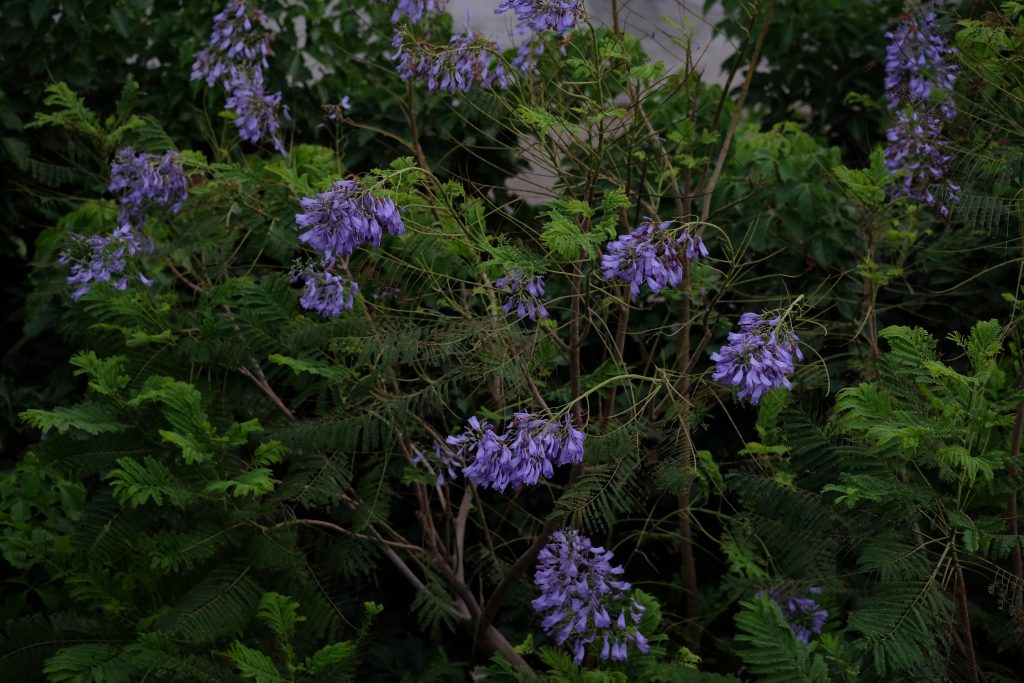
Jacaranda in bloom.
We returned from our summer holidays a few days ago to notice that the jacaranda in our garden had finally bloomed. I say finally, because the tree is approximately six years old and has never bloomed before. For those of you who haven’t seen a jacaranda in bloom, it is quite something. Clusters of purple flowers permeate the fern-like leaves. The overall effect is that of grapes floating in the sky. The one in my garden wasn’t exactly what I’d call ‘in full bloom.’ Maybe a total of six or seven clusters. But for me it was a moment. Not only because it was the first time, but also because the last time I had seen these purple clusters it was March and I was driving from Kilimanjaro airport to Arusha. I had just landed in Tanzania and was heading to the hotel from where we would commence our journey to the top of the tallest mountain in Africa.
Early in 2016, while I was still living in Dhaka, a friend had mentioned that he was planning to climb Kilimanjaro. He asked if I’d be interested and I’d immediately said yes because I always like to think I’m very interested in such things. We moved back to Karachi that summer. But that did not deter him from a) making the plan and b) assuming I would still be part of it. He also managed to get 7 other people on board. I did make feeble attempts to back out as the plan solidified — I really wasn’t sure I had a Seven Summit peak in me. My only form of exercise was ‘regular gymming’. The rest of the group consisted of marathon runners and yoga teachers. Nevertheless, he persisted and eventually succeeded in convincing me. He is a good talker, and clearly I’m easy.
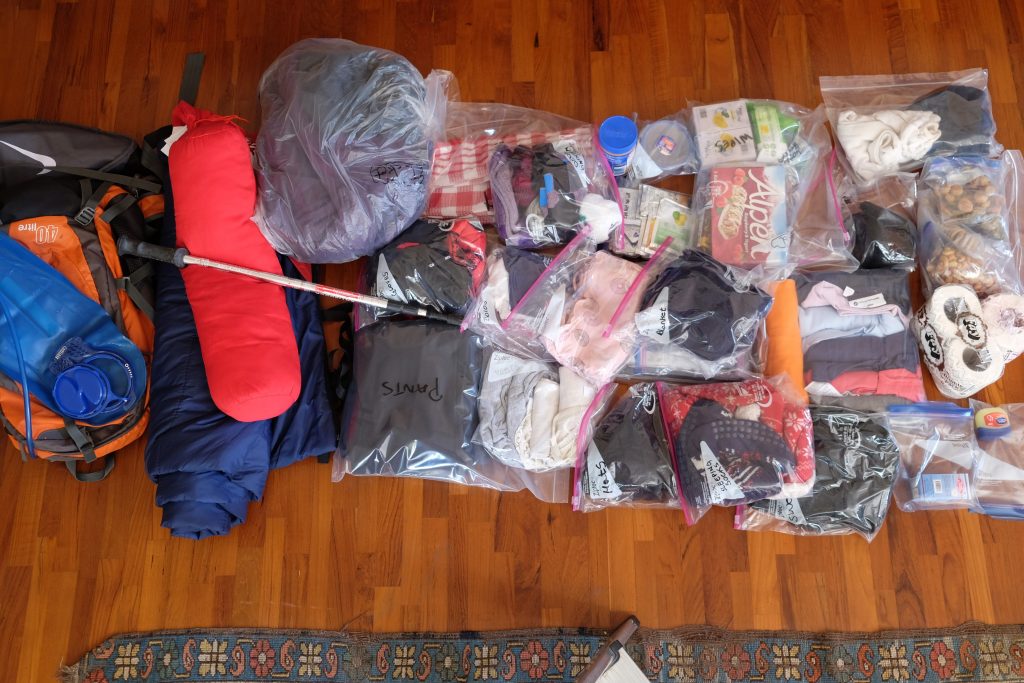
So on March 5th, I packed my bags (in a highly meticulous fashion — see pic above), and got on a plane to Doha, where I met up with a fellow group member and together we travelled to Arusha. I almost didn’t get past Pakistani immigration — standing there without a visa or an invitation letter. I’m certain I managed to squeeze through mostly on the back of my full head of grey — the immigration officers didn’t quite know how to react when I told them what I was hoping to accomplish in Tanzania, given what seemed to be their estimate of my age and physical ability. This was entirely in line with how pretty much everyone I had told had reacted, and therefore I was not at all surprised. Perhaps they just let me through because they took pity on my delusions of grandeur. The following is a short account of my week in Tanzania, climbing the highest free standing peak in the world.
Arrival in Arusha — March 6th, 2017:
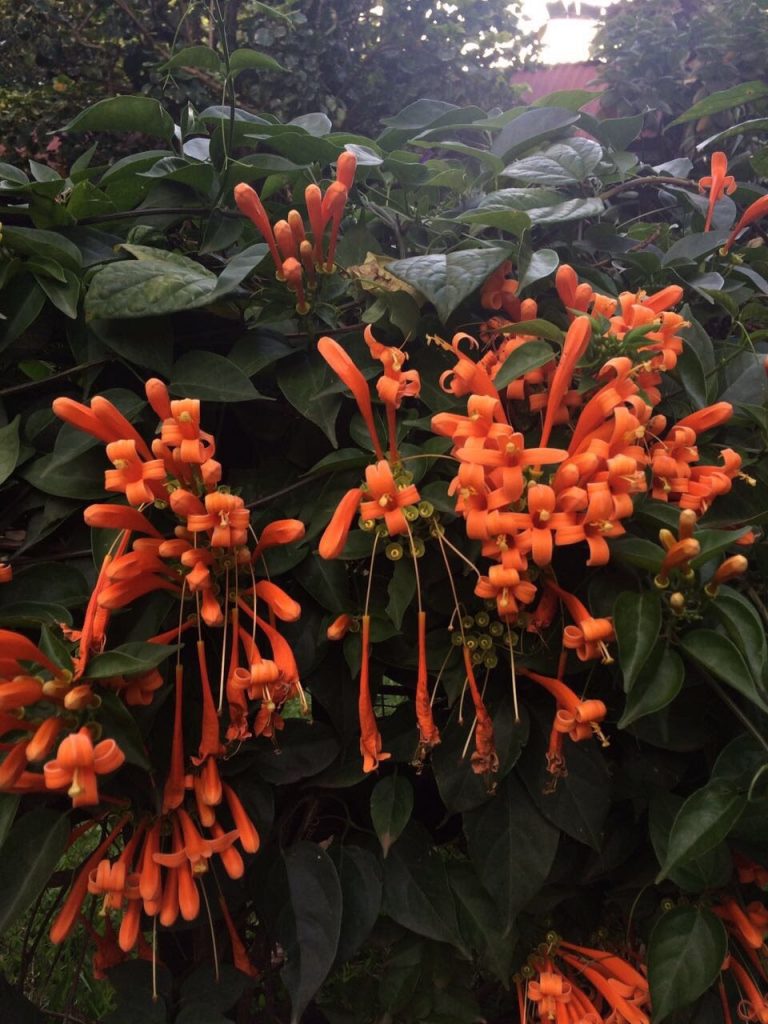
Casually blooming splendour.
We land in Arusha on a hot, but not very humid, afternoon. Arusha airport is small and a lot of manual notation is involved at arrivals — nobody is in much of a hurry. It takes a longish time to get out of a tinyish airport, so lots of time to think all sorts of random thoughts — I can’t believe I’m finally in Africa, all by myself, to climb a mountain etc, etc. Finally into a van and we are making our slow way towards the hotel in Arusha. The van driver and the immigration officer: clearly on the same page. But it doesn’t matter because the earth is as red as I had imagined, the sky as blue, the clouds as puffy white and the jacaranda is in full bloom. And I’m beginning to feel a little like Isak Dinesen [author of Out of Africa].

Old school.
The Outpost Lodge in Arusha is small too. Almost like a bungalow that has expanded to house more guests. The garden is an organised mess of foliage — my eyes and neck are soon exhausted. Most of the group has already arrived and soon we are listening intently to Faraja — the man whose team is to guide us up the mountain. He briefs us and his team conducts a gear check. Turns out I am not as well equipped as I had thought. I have to rent a duffle bag, a sleeping bag, a rain poncho and a summit jacket. Equipment is put in order, and conversation turns to Diamox — the drug that supposedly prevents altitude sickness. I don’t want to take it — I hate taking medicines. But everyone feels it is essential to surviving the altitude sickness that is bound to affect us on the trek. I give in. Told you I’m easy. We go off to our rooms to get a good night’s rest in what is likely to be our last soft bed with pillows for a while to come.
Day 1.

Alighting bag and baggage.
We enjoy a nice open air breakfast and are ready and on the bus by 10:30am. The drive to Marangu gate — the official entrance to Kilimanjaro National park — is fairly long. En route we catch our first sight of Kilimanjaro. The lower half of the mountain is completely hidden behind low lying clouds. Only the peak is visible. It rises up like a Colossus. There is a stunned silence — nobody is willing to imagine that we are most likely going to be standing on top of that peak before the week is out. I, for one, refuse to believe it.
Formalities at the gate and more paperwork later, we are finally inside the park. We drive to a nice grassy patch for an open air lunch overlooking Tanzania/Kenya. The weather is warm, the sky is pretty. We are fresh and feeling strong. Our duffles are loaded off the buses and onto the porters heads and shoulders. There are 32 porters for the 8 of us. It sounds a little excessive, but they need to carry everything the trek will require — our food/tents/clothes, their food/tents/clothes. The only thing we carry is our daily backpack — with our water, day snacks, camera, sunblock, maybe a rain jacket. Believe me, it adds up and I can’t imagine how the porters race ahead of us with their heavy loads. We start at a leisurely pace through dense, wooded forest. Lovely long grasses waving in the breeze, banana palms, the odd hut with a family or two, small plantations of vegetables. Flowers peek out, in orange/red, yellow, white or purple. The day is warm and we walk approximately 7 km, gaining about 600m in height, until the sun sets and our head torches come out. It is peaceful and cool and finally we make it to Simba Camp (approximately 2600m), where our tents and dinner are ready and waiting. I’m already beginning to feel the pangs of privilege.
Day 2:

The peak says hello!

Tent buddies (author on the left)
My tent mate and I awake at dawn — setting what is to be the pattern for the entire hike. We putter around the campsite, making much noise, disturbing everyone. We get our first view of Kibo peak — the volcanic crater that is the peak we are to climb, not too far away and certainly not very steep, looking entirely doable from where we are standing. Lots of pictures and selfies ensue. Breakfast is warm porridge and omelets. We set off once again, this time walking a total distance of about 10 km, gaining aproximately 1000m in height. No sign of any altitude sickness on anyone as yet. The scenery changes, the trees disappear and everything becomes much shorter. It is still lush and green, although the path is rockier and the walk less even than yesterday’s. Streams are crossed and there are a few minor accidents. The sight of Kikilewa camp (aproximately 3600m) and the thought of a hot meal are welcome after a long hard day’s walk. The weather is considerably cooler, but no complaints as the sun has been shining down on us all day. I really am in Out of Africa and it’s pretty darn glorious.
Day 3
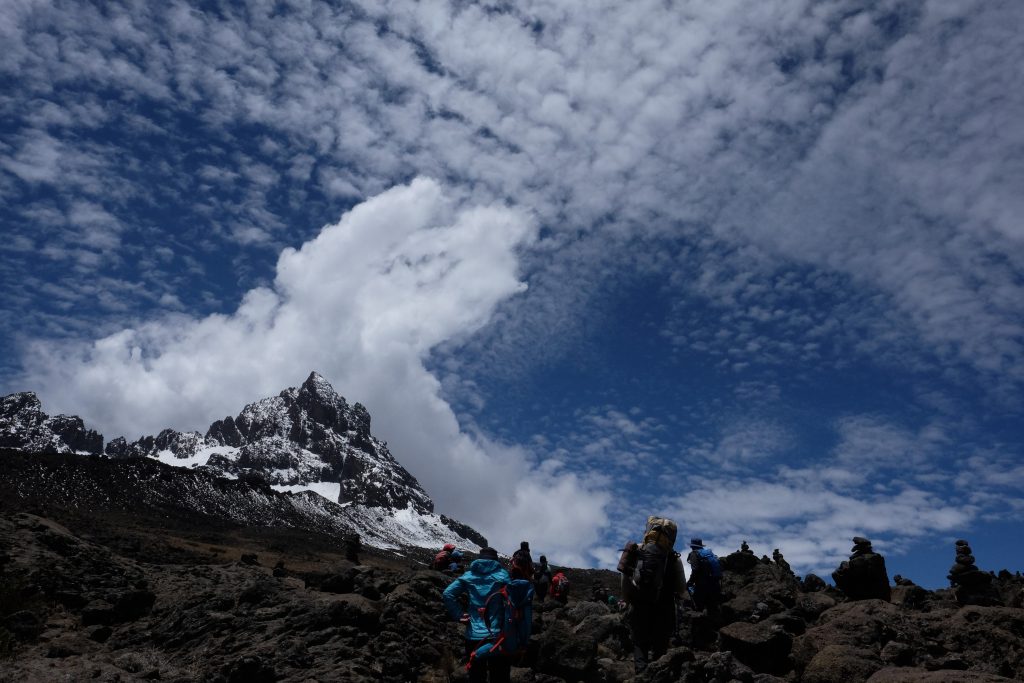
Under the sheltering sky.

Phone signals.
The walk is shorter and steeper on this day. We end up facing the wrong peak — Mwenzi instead of Kibo. We learn that there are actually two peaks on Kilimanjaro. Climbing Mwenzi is apparently not an option. I look up at the serrated edges of the peak and feel relieved. The routing via Mwenzi, however, is to allow us to acclimatize better. We gain approximately 600m in height on this day and it is now officially very, very cold. Snow is visible directly above us and frozen water puddles are visible around the tents. The Mwenzi Tarn camp (aproximately 4300m) is situated around a small water feature, with the ground rising to form the peaks around us. There are several encampments here of other climbing groups, solar panels are visible on tents, people are milling around, enjoying the last moments of warmth before sunset. Our guides lead us upwards, for a short but steep acclimatization hike — some complaints of mild nausea and headache — but generally all are still doing well. Phone signals make a sudden appearance and there is a mad scramble to talk to parents, husbands, wives, children, friends. Back at camp we discover that in an adjoining camp is a group that includes a blind person and another with a prosthetic leg. Here I am worrying about headaches and nausea above 4000m . . . (This is a link to their story — http://www.militarytimes.com/articles/in-her-own-words-how-a-marine-veteran-amputee-conquered-mount-kilimanjaro-for-charity)
Day 4

The snows of Kilimanjaro.
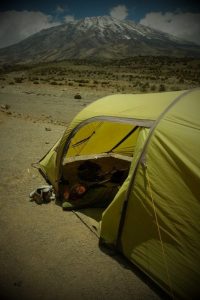
Introspection.
We finally start heading towards Kibo, the peak we will climb on day 5 (night 5 in fact). By now we have started worrying about that particular moment in time and most of the conversation centers on it — a welcome change from a daily discussion of bowel movements. We ascend only a little before descending aproximately 400m towards the Third Caves camp site (aprox 3900m). Another quick acclimatization trick apparently: sleeping in an oxygen rich environment the night before the summit bid is helpful to build some much needed reserves. This camp site offers an uninterrupted view of Mwenzi, and therefore lots of up close and personal contemplation of what it’s going to be like climbing up that snowy peak in the middle of the night — an event which is now less than 24 hours away. The night is restful as the temperature climbs just enough to make the sleeping bag cosy.
Day 5.
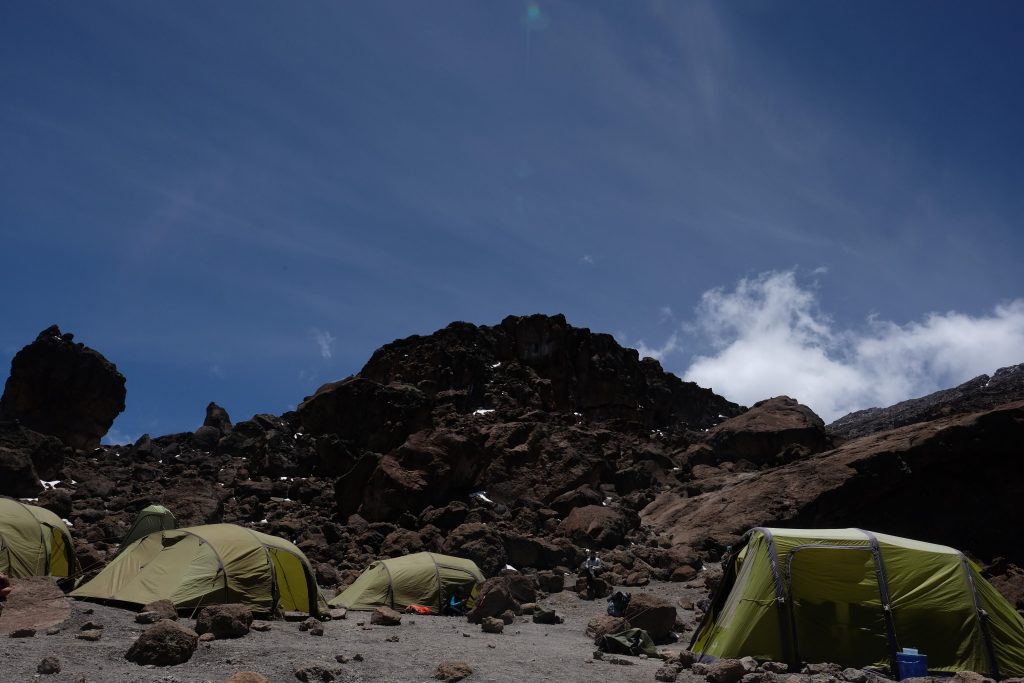
Base camp.

The moon rises on summit night.
Breakfast out in the open under the sun and we are off towards what is essentially the last camp before we ascend to the peak. School hut, elevation 4800m, offers lovely views of Kibo peak and Tanzania/Kenya below. A small acclimatisation hike is scheduled post lunch. It is short, but rocky and steep, so takes a toll on our reserves. Also, we are now not in an oxygen rich environment — there is no vegetation and white clouds lie below us. We retire to our tents around 3pm to rest before the 11pm wake up call for the ascent. There is still very little sign of altitude sickness but I’m definitely worried about the proceedings that lie before us. At 11 pm we are summoned to collect in the mess tent. We try to force down some ‘breakfast’ and prepare our backpacks. The ascent is to culminate at dawn, at Gilman’s point (5700m), so we need about 7 hours worth of water and some snacks to keep us going. It’s all sounding a little bit too stressful and I am already frozen and ready to give up and go back down. But no one is having any of it. I grudgingly follow the others and we begin to climb.
Night 5/Day 6.
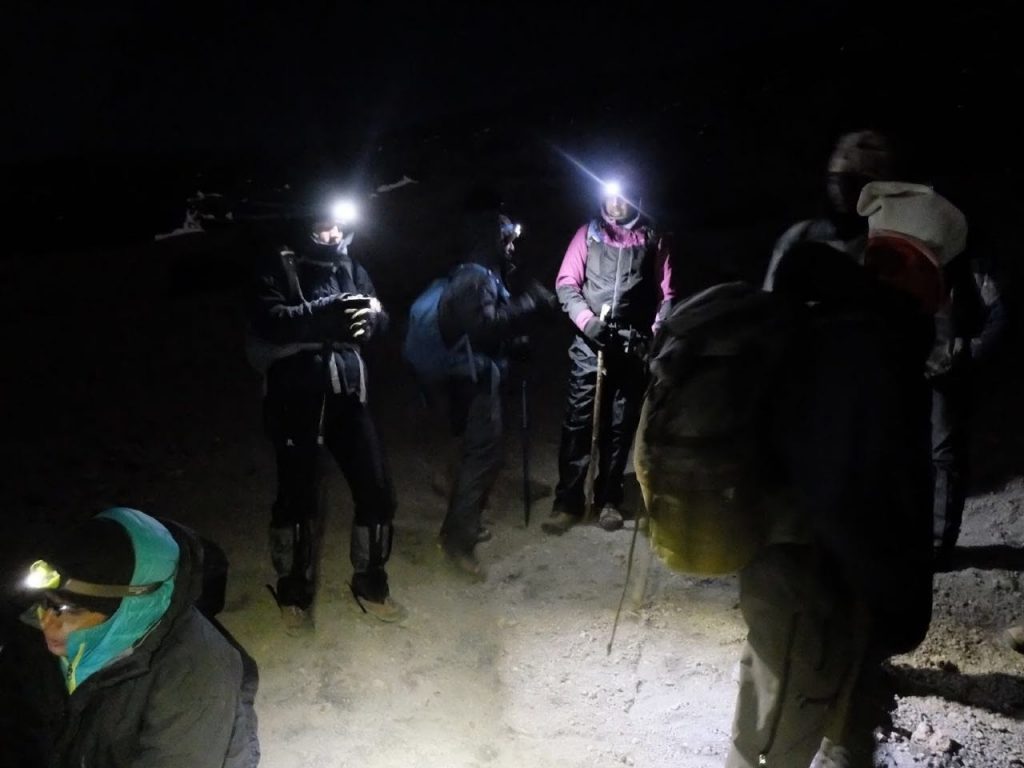
Nearing the summit.
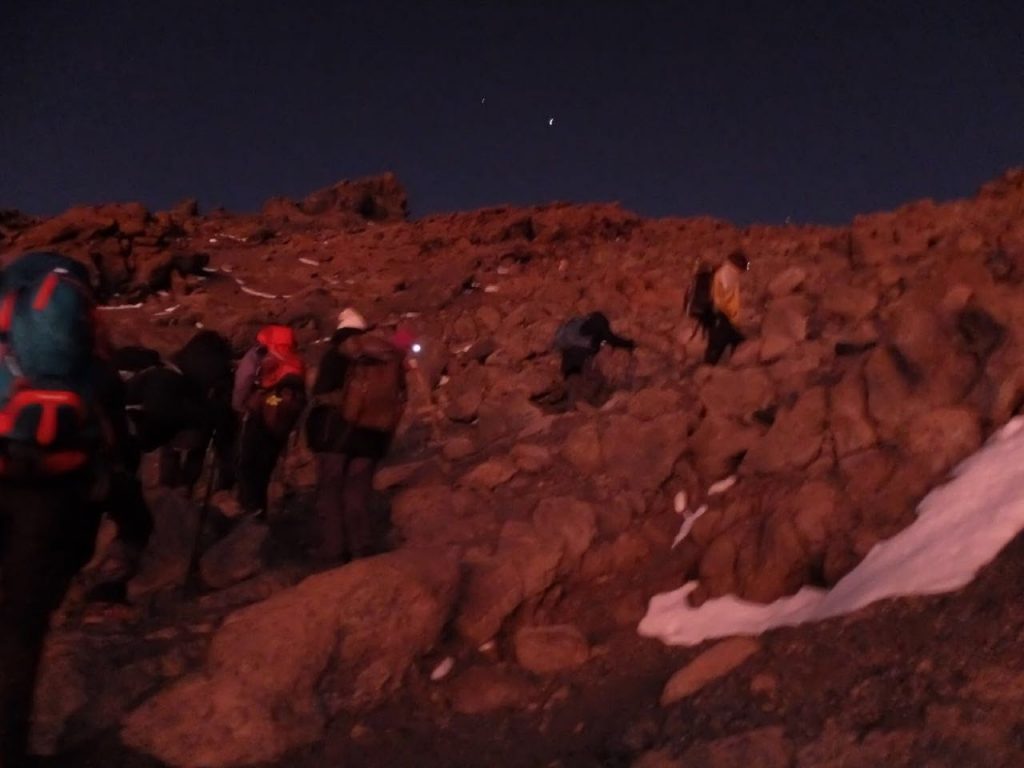
Almost there.
I can’t speak for the rest, but for me the entire 7 or so hours during ascent are spent wondering what on earth possessed me to make this decision, to come to Africa, to climb this mountain, to climb it to the top. It is one long contemplation of all the crazy decisions and conversations that led to these 7 hours. When I think back, my only real memory of the walk itself is of constantly wanting to stop for breaks but not being able to tolerate it when we did, thanks to the freezing and shivering that would immediately set in. Of mindlessly trudging on and on, slow but steady, measuring time in the number of stops, aproximately every 45 mins. Of my water freezing in the straw leading to my hydration pack, of my head starting to pound as I slowly dehydrated. Of getting distracted by the guides’ lilting songs, but only very momentarily. Of alternately staring at the moon ahead and searching for the sun on the gently curving horizon line behind, willing one to set and the other to rise. Of constantly looking at my co-trekkers and wondering, are they dying too or is it just me? Not a word is exchanged as we labour on. All the banter from the previous days, the camaraderi, the small talk, the gossip, the lofty talk of life being all about pushing oneself out of one’s comfort zone etc etc, all evaporate into the literally thin air around us.
Finally, after what seems like a lifetime of placing one foot ahead of another, the moon disappears behind the ridge in front, and the horizon behind indicates a thin line of orange. A shout goes up, Gilman’s has been sighted above. I can only cry with relief that the night has finally come to an end, that I have made it, without either rolling down the hill or sitting down and giving up. We scramble onto Gilman’s point, and sit down on rocky perches. The guides start handing out red bull and pringles. We are looking at each other, dazed and confused. All I want to do is turn around and start the descent. After all that hard work going up, I really, really, really want to get off this mountain.
And then, Faraja announces that we will now walk to the ’peak’ — Gilman’s point apparently brings you to the top of the crater but the official peak is Uhuru, a mere 150m above where we are standing but a 2 hour walk along the crater. I look at him in disbelief. A quick mental calculation — not easy given the state I am in — shows me that I only have enough reserves left for the descent. (It is worth mentioning here, that all the people we had met at the lodge prior to our departure for the mountain had been very clear on this — the descent, they said, is pretty hellish). With that in mind, I make the call. I’m going back down, I announce to everyone. Now, everyone else looks at me in disbelief. I envy you says one. Others can’t believe I’ve done all that work and am turning around 150m short of the official peak. But my mind is made up. I am very clear on how this is going to go down. Faraja appoints a guide to accompany me and we set off. Thankfully, no one tries to stop or come along with me — summiting is important for them and I don’t want them to regret it later.
It takes me four hours to get down to Kibo huts, part skidding, part walking, taking off layers of thermals as the air around me heats up, stopping every fifteen minutes to sip water. I reach the campsite and collapse onto a mat laid out for me in the mess tent. I have vague memories of the rest of the group arriving in ones and twos — most suffering from nausea and vomiting. One has caught a stone inside her shoe and is sporting a bleeding toe. I keep waking up and passing out. At one point I remember sitting up and right in front of me, sitting three on one side of our lunch table and four on the other, are seven faces resting on hands propped on elbows, eyes closed, mouths open, all fast asleep in their chairs. I wish desperately for my camera to fly out of my duffle to me but before that can happen I pass out again.
Some hours later, we are all up and somehow, miraculously, readying to hit the road. It turns out Kibo was just a lunch stop — our tents are actually at Horombo, 9.6 km away. Bear in mind, that since the previous night most of us have already walked aproximately 5 km from School hut up to the summit (5895m) and aproximately 5 km from the summit down to Kibo Huts (4700m). And now another 10ish km lie between us and our sleeping bags. What to do but walk.
I will say here that I do not regret turning around from Gilman’s. Not even for a second. What I do regret is not having the strength or the will to carry my camera for the walk from Kibo to Horombo. We walk through some of the most spectacular scenery the mountain has to offer. It changes from the snowy peaks of an alpine desert on the one end, to dense, marshlike forest featuring the Kilimanjaro Senecio at the other. It is bizzare beauty like I have never seen before, and I am in it for almost five hours. I lag behind all the others but I have guides Calvin and Robin to make sure I survive and one kind group member who keeps me company, chatting nonchalantly about books, music, life — anything to keep me from focusing on my physical state. I don’t know how, but I make it to camp. I can barely speak, I can barely eat. I’m not carrying my phone but others are and the signals are back on. My family is trying desperately to get a hold of me through them, to hear why I couldn’t make it to the summit — they’ve been following the blog our guide company has been vaguely updating — to hear I’m doing ok. But I don’t even have the energy to text. I force two morsels of brown rice down my throat, pop two panadols and retire to my tent. I pile on all my thermals, climb into my sleeping bag, clutching my hot water bottle to my chest, not entirely sure I will ever wake up again.
Day 7
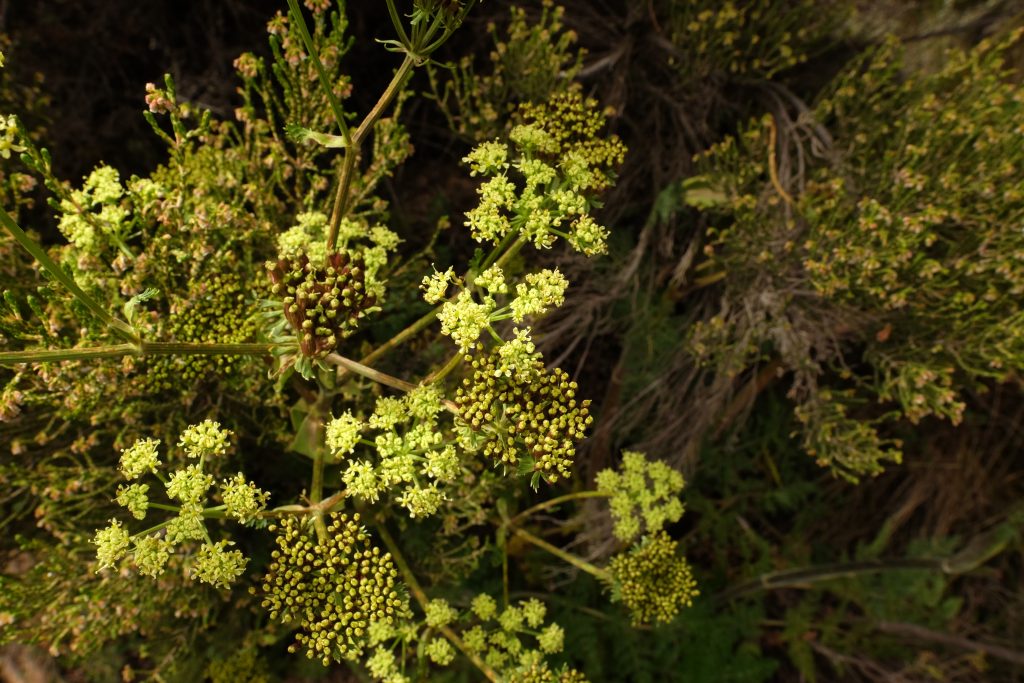
Wilderness.
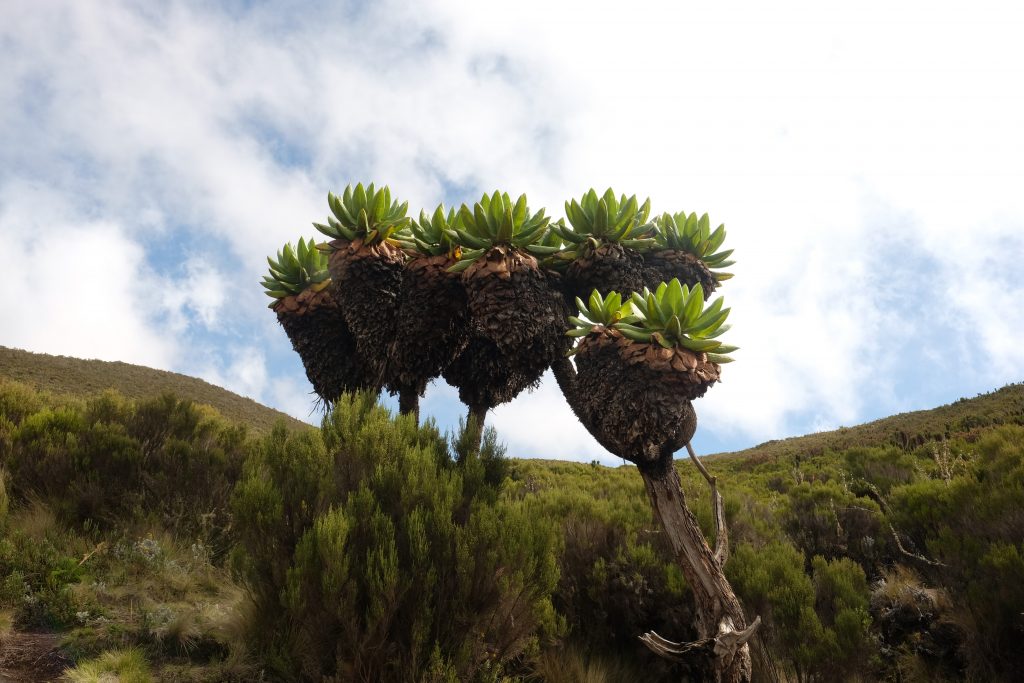
The magnificent Senecio.
Not only do I wake up, I do so feeling like a million dollars. It’s as if a new age has dawned. A rescue bus has been arranged for those who are not in the best shape — the previous night I had been on top of that list. But this morning it is as if last night never happened. So I am up and ready to do what I love — walk under the beautiful, open sky. Three decide to take the bus. The rest of us set off behind our guides, for a 20ish km walk through some very unusual flora and fauna. The trails are fairly well maintained and we are going gently downhill so it isn’t very difficult. My toenails have turned blue however, due to all the pressure that they suffered descending from Gilman’s. It is painful and at some point I have to switch into Calvin’s shoes which are a size bigger and therefore less tight on the toes.
No regrets on talking the walking option though. The day is sunny, the breeze is cool and the last few kms take us through what is essentially a rainforest. Beautiful. On the way down we pass several groups of people going the opposite way — including what seems to be an entire Chinese village — all looking fresh and happy, blissfully unaware of what awaits them in the days and hours ahead. We cannot help but collapse into hysterics. It feels quite lovely to be alive and not nauseous. The rescue bus is waiting to take us the last 4 or so km. We clamber in, and, ten minutes later, are back where we started — Marangu gate — for certificates and the bus that takes us back to Arusha. Lunch at a burger joint — I don’t know if the burgers are actually as good as the tour company had promised they would be, but it’s the most flavourful food we’ve eaten in a while. Back at the hotel by early evening and the plan is to get ready and meet in the lobby for dinner but everything gets delayed because no one wants to get out of the shower. . . clearly we missed our creature comforts. Dinner, at a nice restaurant out in the open, under the trees, but this time with pretty cutlery and crockery and napkins and clean hair. . . just amazing what a huge difference the little things in life make.
Early the next morning people head off in their respective directions — Dhaka, Bombay, Kenya. Two of us are left behind to explore Arusha for a few hours before our flight back to Doha and onwards. We walk through the streets, the flowers, the trees, and all I can think is I need to come back here very, very soon.
And even though I had vowed never to speak to my friend who coaxed and cajoled me into this (mis?)adventure, we recently chatted about another plan — similar in scope and madness — for next year. And of course I’m going to say yes. Probably don’t need to tell you why.
Photos by the author.



